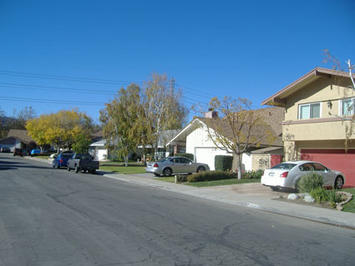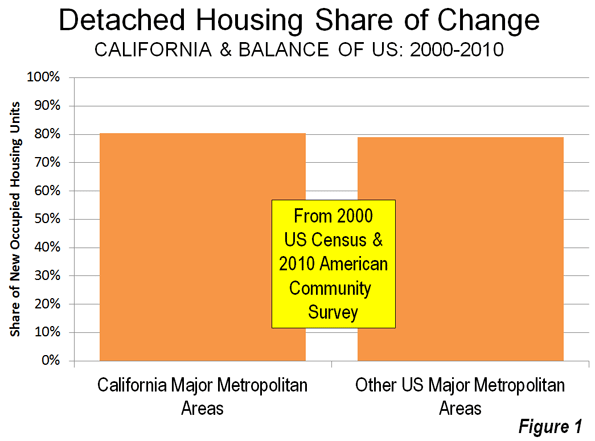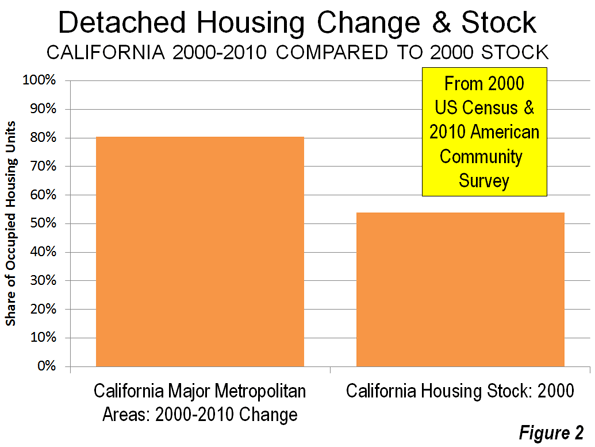
My April 9 Cross Country column commentary in The Wall Street Journal (California Declares War on Suburbia) outlined California's determination to virtually outlaw new detached housing. The goal is clear: force most new residents into multi-family buildings at 20 and 30 or more to the acre. California's overly harsh land use regulations had already driven housing affordability from fairly typical levels to twice and even three times higher than that of much of the nation. California's more recent tightening of the land use restrictions (under Assembly Bill 32 and Senate Bill 375) has been justified as necessary for reducing greenhouse gas (GHG) emissions.
It is All Unnecessary: The reality, however, is that all of this is unnecessary and that sufficient GHG emission reductions can be achieved without interfering with how people live their lives. As a report by the McKinsey Company and The Conference Board put it, there would need to be "no downsizing of vehicles, homes or commercial space," while "traveling the same mileage." Nor, as McKinsey and the Conference Board found, would there be a need for a "shift to denser urban housing." All of this has been lost on California's crusade against the lifestyle most Californians households prefer.
Pro and Con: As is to be expected, there are opinions on both sides of the issue. PJTV used California Declares War on Suburbia as the basis for a satirical video, Another Pleasant Valley Sunday, Without Cars or Houses? Is California Banning Suburbia?
California's Increasing Demand for Detached Housing? A letter to the editor in The Wall Street Journal suggested that there are more than enough single-family homes to accommodate future detached housing demand in California for the next 25 years. That's irrelevant, because California has no intention of allowing any such demand to be met.
The data indicates continuing robust demand. In California's major metropolitan areas, detached houses accounted for 80 percent of the additions to the occupied housing stock between 2000 and 2010, which slightly exceeds the national trend favoring detached housing (Figure 1). If anything, the shift in demand was the opposite predicted by planners, since only 54 percent of growth in occupied housing in the same metropolitan areas was detached in 2000 (Figure 2).


Watch What they Do, Not What they Say: It does no good to point to stated preference surveys indicating people preferring higher density living. Recently, Ed Braddy noted in newgeography.com (Smart Growth and the New Newspeak) that a widely cited National Association of Realtors had been "spun" to show that people preferred higher density living, from a question on an "unrealistic scenario," and ignoring an overwhelming preference for detached housing – roughly eighty percent – in other questions in the same survey. People's preferences are not determined by what they say they will do, but rather by what they do.
Off-Point Criticism: There was also "off-point" criticism, which can be more abundant than criticisms that are "on-point." Perhaps the most curious was by Brookings Institution Metropolitan Policy Program Senior Researcher Jonathan Rothwell (writing in The New Republic) in a piece entitled "Low-Density Suburbs are Are Not Free-Market Capitalism." I was rather taken aback by this, since none of these three words ("free," "market" or "capitalism") appeared in California Declares War on Suburbia. I was even more surprised at the claim that I defend "anti-density zoning and other forms of large lot protectionism." Not so.
Indeed, I agree with Rothwell on the problems with large lot zoning. However, it is a stretch to suggest, as he does, that the prevalence of detached housing results from large lot zoning. This is particularly true in places like Southern California where lots have historically been small and whose overall density is far higher than that of greater New York, Boston, Seattle and double that of the planning mecca of Portland.
Rothwell’s own Brookings Institution has compiled perhaps the best inventory of metropolitan land use restrictions, which indicates that the major metropolitan areas of the West have little in large lot zoning. Yet detached housing is about as prevalent in the West as in the rest of the nation (60.4 percent in the West compared to 61.9 percent in the rest of the nation, according to the 2010 American Community Survey). Further, there has been little or no large lot zoning in Canada and Australia, where detached housing is detached, nor in Western Europe and Japan (yes, Japan, see the Note below).
On-Point: Urban Growth Boundaries Do Increase House Prices: However, to his credit, Rothwell points out the connection between urban growth boundaries and higher house prices. This is a view not shared by most in the urban planning community, who remain in denial of the economic evidence (or more accurately, the economic principle) that constraining supply leads to higher prices. This can lead to disastrous consequences, as California's devastating role in triggering the Great Recession indicates.
The Purpose of Urban Areas: From 1900 to 2010, the urban population increased from 40 percent to 80 percent of the US population. Approximately 95 percent of the population growth over 100 years was in urban areas. People did not move to urban areas the cities for "togetherness" or to become better citizens. Nor did people move out of an insatiable desire for better urban design or planning. The driving force was economic: the desire for higher incomes and better lives. A former World Bank principal urban planner, Alain Bertaud stated the economic justification directly: "large labor markets are the only raison d’être of large cities."
And for the vast majority of Americans in metropolitan areas, including those in California, those better lives mean living in suburbs and detached houses. All the myth-making in the world won’t change that reality, even if it pushes people out of the Golden State to other, more accommodating pastures.
The performance of urban areas is appropriately evaluated by results, such as economic outcomes, without regard to inputs, such as the extent to which an area conforms to the latest conventional wisdom in urban planning.
- Land use policies should not lead to higher housing costs relative to incomes, as they already have in California, Australia, Vancouver, Toronto and elsewhere. If they do, residents are less well served.
- Transport policies should not be allowed to intensify traffic congestion by disproportionately funding alternatives (such as transit and bicycles) that have little or no potential to improve mobility as seems the likely outcome of radical densification. If they do, residents will be less well served.
This gets to the very heart of the debate. The "smart growth on steroids" policies now being implemented in California are likely to lead to urban areas with less efficient personal and job mobility, where economic and employment growth is likely to be less than would otherwise be expected. The issue is not urban sprawl. The issue is rather sustaining the middle-income quality of life, which is now endangered by public policy in California, and for no good reason.
Wendell Cox is a Visiting Professor, Conservatoire National des Arts et Metiers, Paris and the author of “War on the Dream: How Anti-Sprawl Policy Threatens the Quality of Life”
----
Note: Despite its reputation for high density living, Japan's suburbs have many millions of detached houses. In 2010, 47 percent of the occupied housing in Japan's major metropolitan areas was detached (Tokyo, Osaka-Kobe-Kyoto, Nagoya, Sapporo, Sendai, Hiroshima, Kitakyushu-Fukuoka, Shizuoka and Hamamatsu).
Photo: An endangered species: Detached houses in Ventura County (Photo by author)













Thanks so much for this
Thanks so much for this wonderful website as well as this post. This post is the kind of thing that keeps me on track through. I’ve been looking around for this site after I heard about them from a buddy and was thrilled. Thanks a bunch.
Free Cell phone spy
It is not a secret that
It is not a secret that Italian food is one of the most popular classes of food in the world and chicken lasagna recipe is king. Lasagna is an extremely versatile dish that can be changed and created in many new and tasty interpretations. The basic lasagna recipe calls for pasta, ground veal or ground beef, tomato sauce and ricotta cheese. This does not mean that this is the only way that people can enjoy a dish of welcome and filling lasagna.
This info is very good for
This info is very good for me.This site is awesome. My spouse and i constantly come across a new challenge & diverse in this article. - Melia Propolis
I am find information on
I am find information on this topic as I am working on a business project. Thank you posting relative information and its now becoming easier to complete this project. - cream walet asli
Where could single family housing go though?
In the Bay Area it had to escape to the central valley thus the Stockton and other area eventual collapse being 60 miles from the job centers, likewise in LA you go to the Inland Empire or the High Desert, being up to 120 miles from job centers? Essentially natural geography has placed effective limits on the size of the big metro areas in CA. Perhaps the simple solution is to start a movement to encourage folks to move out of CA in general, but don't stop until you get east of the Rockies.
Easy Solution
Move the job centers. Manufacturing areas in particular can benefit from less railroad congestion, being close enough to the city to use the junctions there but far enough out that their primary shipping point has very little congestion en route. Commercial areas too often move outward, as can be seen with the banks that have offices in Manchester (near London), Long Island City (near NYC) or Bellevue (near Seattle). Occasionally such an area will hold on to the industry after the old leaders in the city center go belly up, as may soon happen in Bellevue and has happened with Atlantas textile industry, now mostly based out of Roswell and Dalton.
As costs increase in LA and San Francisco, the pressure to leave will also rise. Keep in mind that high real estate prices hurt businesses too, which is why much of LA's high-tech aerospace sector is moving out to Mojave.
click here to find out more
I genuinely enjoyed reading it, you're a great author.grosir baju korea will ensure that I bookmark your blog and definitely will come back later on. I want to encourage yourself to continue your great job, have a nice morning. This website has very good content. That is a great idea, I am very glad to read this post, and I agree with the issues of this write-up.